Nambu
World: Order of the Golden Kite
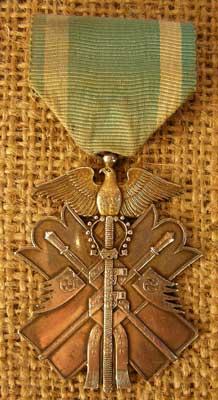
This order was awarded for
distinguished military service in war only and could be received only by
Japanese. There were seven classes. It is covered on pages 14-21 of OMJAS. The
one I have and that is shown here is the Seventh Class, i.e. the lowest. Your
rank determined which classes you were eligible to receive. Based on the period
photos I have, it seems that even military men got it much less often than the
other two orders. The Japanese term for the Order of the Golden Kite is kin-shi kun-sho. Kin means gold and shi
(also pronounced tobi) means “kite”
in the sense of a bird that is part of the hawk family (not the kind of kite
that kids fly on windy days; that is called a tako). Kun-sho, as above,
means “meritorious deed medal”. The reference to a golden kite is an allusion
to a famous incident in Japanese ancient history/mythology in which the bird
advised Emperor Jimmu, the first Emperor of Japan, to attack from the east at
dawn. The golden bird perched above the Emperor so that its reflection blinded
the enemy and Jimmu won, thereby establishing the imperial lineage which has
lasted over 2600 years. Here is a closer shot of the main part of the medal. It
measures 45 mm wide by 53 mm high (1-3/4” X 2-1/8”).

The back is blank, with no
inscription or markings. Note that the medal is attached to the ribbon with a
ring, unlike the service medals. It seems to be made of silver.

Here is the box, which is made of
black lacquerware. The characters on the box say ko-nana-kyu-kin-shi-sho. The box is 58mm wide by 90mm long by 24mm
thick (2-5/16” X 3-9/16” X 15/16”). This is smaller than the service medal
boxes.
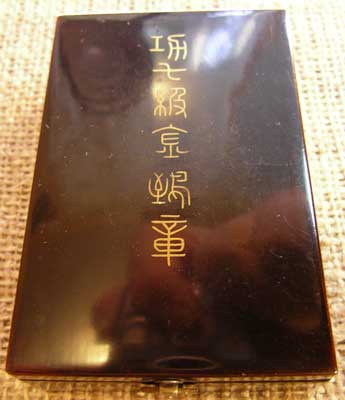
The box closes by means of a clasp
that consists of a little hinged flap on the top half that fits over a peg on
the bottom half. I am not sure what metal this closure mechanism is made of
except that it is not steel based on a magnet test.
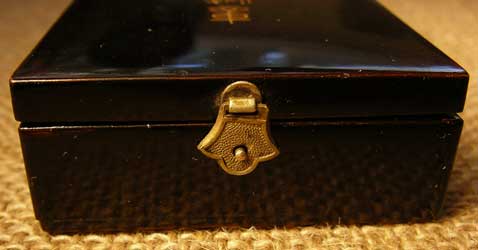
Here is the medal in its box, which
is plush lined. Note that the ribbbon is folded underneath itself at the top,
with the top going into a little compartment underneath the level that the
medal rests on, unlike the service medals and the other two orders shown on
this site, which lay flat in their boxes.
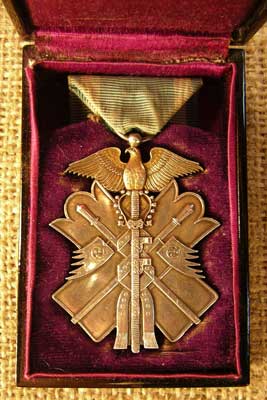
The certificate for this medal is
quite large. It measures 596mm X 458mm (23-1/2” X 17-7/8”). It has watermarks
in the upper right and lower left corners (shown below), but nothing is written
or stamped on the back of the certificate.
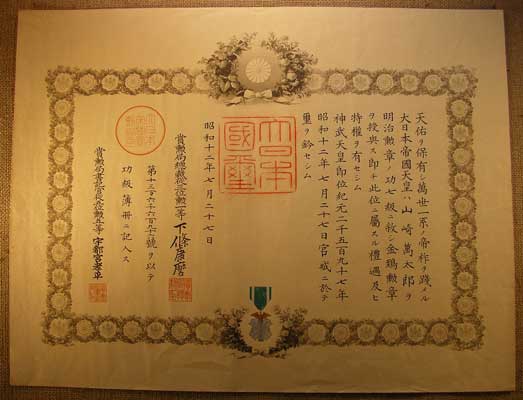
The most important information is on
the right side, which records the recipient’s name and the date of the award. The
writing is in vertical (top down) columns, starting at the right and working
across towards the left. Here is the text in Japanese, followed by a
translation:
First column on
right: ten-yu-o-ho-yu-shi-ban-sei-ik-kei-no-tei-so-o-fu-meru
Second column from right: dai-nippon-tei-koku-ten-no-wa-yama-zaki-ban-ta-ro-o
Third column from right: mei-ji-kun-sho-no-ko-nana-kyu-ni-jo-shi-kin-shi-kun-sho
Fourth column from right: o-ju-yo-su-sunawa-chi-kono-i-ni-zoku-suru-rei-gu-oyo-bi
Fifth column from right: tok-ken-o-yu-seshimu
Sixth column from right: jim-mu-ten-no-soku-i-ki-gen-ni-sen-go-hyaku-kyu-ju-nana-nen
Seventh column from the right: sho-wa-ju-ni-nen-shichi-gatsu-ni-ju-nano-ka-kyu-jo-ni-oi-te
Last column on left: ji-o-?-seshimu [I could not identify the third symbol from the top, though the meaning is clear both from the context and the OMJAS translation].
I was somewhat
lucky because OMJAS translates a certificate for this very medal on pages
20-21. However, I have not followed their translation very closely both because
I preferred my own style of wording and because there is at least one major
error in their translation. They translate kyujo,
“The Emperor of Greater Japan, having come to the Imperial throne in
an unbroken Imperial line with divine guidance, confers the Meiji Order of
Merit, Seventh Class, and awards the Order of the Golden Kite to Bantaro Yamazaki
[surname Yamazaki] along with the honours and privileges appurtenant thereto.
The Imperial Seal has been affixed in the

The left side has the formalities
from the Board of Decorations. Surnames are underlined in the following
translations. The big round red seal at the top says dai-nip-pon-tei-koku-sho-kun-kyoku-in, “Seal of the Board of
Decorations of the Empire of Greater Japan”. The first column on the right has
the date, July 27, Showa 12 (1937). The second column says sho-kun-kyoku-so-sai-ju-san-i-kun-it-to-shimo-jo-yasu-maro:
“President of the Board of Decorations Yasumaro Shimojo, Junior Third
Rank, and holder of the First Order of Merit. The third and fourth columns say dai-ju-san-man-roku-sen-rop-pyaku-kyu-ju-roku-go-o-motte-ko-kyu-bo-satsu-ni-ki-nyu-su:
“We have entered number 136696 in the Register of Grades of Merit” (this is the
number of the certificate). The last column on the far left says sho-kun-kyoku-sho-ki-kan-ju-go-i-kun-go-to-u-tsu-nomiya-ko-hei:
“Secretary of the Board of Decorations Kohei Utsunomiya, Junior Fifth
Rank, Holder of the Fifth Order of Merit”. The square-ish red seals at the
bottom repeat the titles (President and Secretary) of the individuals whose
names are affixed. Such seals are often used instead of signatures in
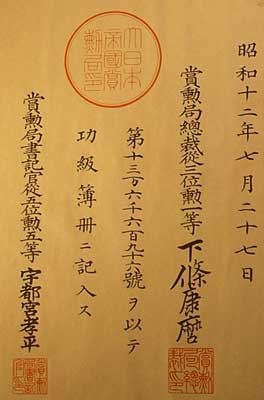
Here is a close-up of the artwork in the top
middle of the certificate, with the Imperial chrysanthemum in the centre.
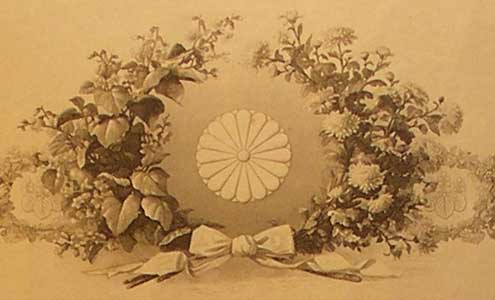
The big red seal in the centre reads
from upper right down, then upper left down. First (right) column: dai-nip-pon. Second (left) column: koku-ji. Together it means “Imperial
Seal of Greater Japan”. The kanji in the lower left, ji=Emperor’s seal, gave me some trouble, as it is rather rare and
written in an ancient fancy script style. I finally realized that it was the
same as a printed character on the right side of the certificate and was able
to find it on page 55 of Nelson’s Japanese-English
Character Dictionary, Second Revised Edition, where it is kanji #71.
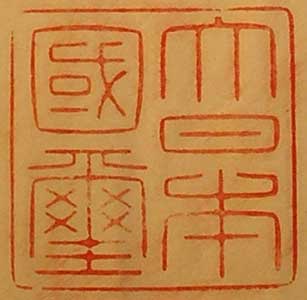
Here is a close-up of the artwork in the bottom
centre.
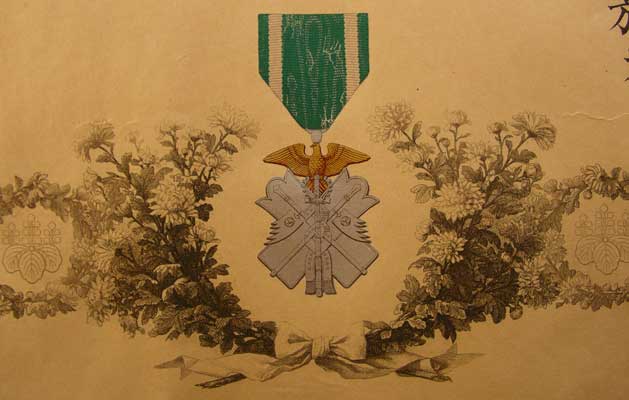
This is the watermark in the upper
right corner. It is the Imperial Chrysanthemum. The photo appears very orange
because I had to put an incandescent lamp directly behind the certificate to
get the watermark to show up and to have enough light to get a shutter speed
that would allow a clear, sharp shot.

This is the much smaller watermark
in the lower left. It is a sakura
(cherry) blossom with the character in (short
for insatsu=printing) inside it. I
think that means the certificate was printed by the Government Printing
Department of the Empire of Greater Japan.

The sakura watermark is in the lower
left corner. This shot of that area shows the border pattern, which alternates
between the Imperial chrysanthemum and another Imperial symbol, paulownia
leaves.

To
return to the base page on Medals, please click here: Nambu World: Japanese Medals
To return to “Other Japanese
Militaria”, please click here: Nambu World: Other Japanese
Militaria
To return to the home page, please
click here: Nambu
World: Teri’s WWII Japanese Handgun Website
Last updated: July 29, 2006. All contents are copyright Teri unless
otherwise specified and may not be used elsewhere in any form without prior
permission.